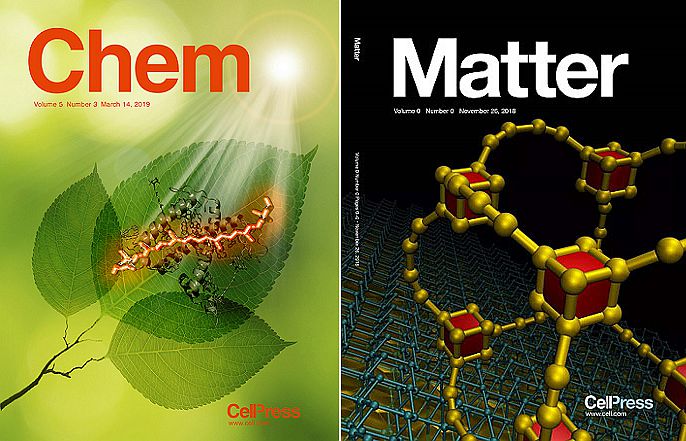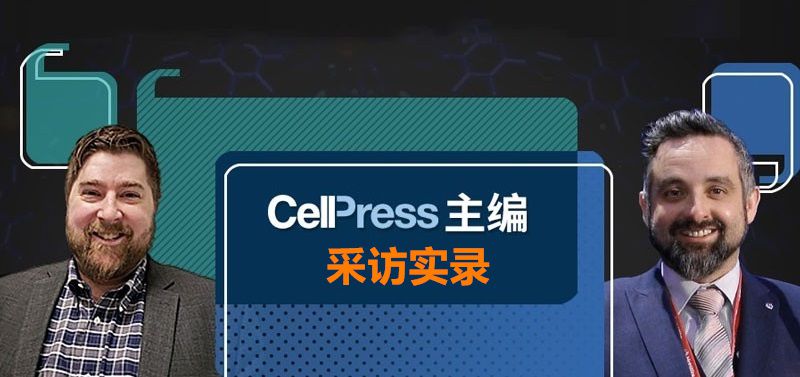面对中国读者的花式提问,Chem和Matter主编这样回答
不久之前,Cell Press细胞出版社与X-MOL合作,邀请广大读者采访化学旗舰期刊Chem的主编Robert Eagling博士与即将正式出版的材料学旗舰期刊Matter的主编Steven Cranford博士(点击阅读相关内容)。
由于大家的热情参与,两天内就收到了大量反馈,大家对二位主编及其杂志提出了很多有洞见、有趣、又刁钻的问题,其中不乏大家最关心的中稿及期刊订阅问题。面对各式各样的“花式”提问,二位主编可谓知无不言,非常精彩。

这些问题中最实际、科研人员最关心的莫过于稿件“接受率”和“发表周期”。
Eagling博士说道,Chem 的总体稿件接受率目前在10%左右,有80%投稿会直接被拒而不安排送审;根据领域以及修改程度的不同,Chem 从投稿到出版周期约为3至6个月,不过Eagling博士也提到Chem 会持续改进以在保证论文质量的前提下尽量缩短出版周期。
Matter 因为还没有正式出版,Cranford博士根据Matter 的定位预计出版周期可能在3个月,而稿件接受率约在8%至10%。

Matter主编Steven Cranford博士(左)与Chem主编Robert Eagling博士(右),图片来源:Cell Press
大家的提问中有的问题非常直接,甚至可以说比较犀利。
例如,提给Chem 主编Eagling博士的一个问题直言“目前许多论文的结果不能被其他研究人员重复,有时是因为作者刻意隐瞒了一些关键步骤的信息”,并询问Eagling博士如何评价这一现象,Chem 又会采取什么样的应对措施。
Eagling博士坦言,不光化学领域,几乎所有科学领域的论文都遇到了结果可重复性的问题。他认为,已发表论文的研究结果能够被成功重复对于该领域的发展至关重要,而无论何种原因,未在论文中包含关键细节或步骤在道德上是错误的,并可能导致严重后果。在Cell Press和Chem,除了通过严格但公平的审稿流程来发现此类问题,还将采用Cell Press在生命科学期刊中已经采用的STAR Methods系统,该系统要求作者非常详细地报告他们的实验和方法,包括试剂的提供方和设备的名称,以保证可重复性。但不得不承认,大多数时候,不可重复的问题是在论文发表之后才会被发现。一旦发生这种情况,论文就可能会被撤稿。
Matter 主编Steven Cranford博士采访视频,视频来源:Cell Press

想知道他们究竟如何回答大家的问题?下面为大家奉上他们中英文回答全文。
Chem主编Robert Eagling博士
采访实录(中文版)
1.Chem的总体接受率和发表周期是怎么样的?今年Chem在提高期刊影响因子方面有何计划?Chem对化学学科下的研究领域有任何偏好吗?
Eagling博士:目前Chem的拒稿率约为90%,没有送审就被直接拒稿的约为80%。论文发表所需时间取决于论文所涉及的领域和所需要的修改程度。我们的目标是在21-28天内做出第一个决定,然后是修改和进一步审稿(根据需要),从投稿到出版的周期约为3到6个月。我们的长期目标是在出版周期方面努力保持与Journal of the American Chemical Society的竞争力,该杂志以非常快的出版周期而闻名。更重要的是,我们必须继续比我们的竞争对手Nature Chemistry 更快。
影响因子无疑是一个关键指标,在中国也一样重要。像我们通常所做的那样,我们会将其与其他关键指标(例如全文下载和媒体报道)放在一起推广。今年6月,新的2018年影响因子将发布,我们预计Chem的影响因子相比2017年将会大幅增长。
关于对化学学科研究领域的偏好?答案是否定的,我们没有偏好。我和编辑们在阅读每篇投稿文章时都会考虑的重点是:提出的问题是什么?这是否会显著推动该研究领域的发展?该文章报道了什么样的概念性进步?该文章是具有广泛、普遍的吸引力还是更适合专业期刊?
2.Chem在与同一领域的其他期刊竞争中的定位是什么?
Eagling博士:自推出以来,我们的目标一直是在大化学领域排名第一,并被公认为真正的Cell 姐妹刊。现在,我们仅仅推出了5卷(自2016年推出以来),与我们的主要竞争对手相比,Chem 已经取得了长足的进步。我们获得的第一个影响因子为14.1(Clarivate,2017),今年的影响因子(2019年6月公布)我们预计还会进一步提高。这将使Chem 成为排名第二的化学期刊,仅落后于Nature Chemistry。其他方面的提升,如历史和声望,还需要更长的时间,因为像Journal of the American Chemical Society 和Angewandte Chemie 这些老牌期刊已经为化学界服务多年。然而,我们已经取得了非常好的开始,并将继续推动期刊的发展,追求卓越的同时始终提供优秀的客户服务。最重要的是,我们将继续与化学界密切合作,以确保我们传播的是当今世界上最令人兴奋的化学研究。
3. 在影响因子更高的期刊上发表的研究论文,并不一定在工业上具有更高的实用价值。您在平衡这类问题上有什么看法?
Eagling博士:确实,在高影响因子期刊上发表论文并不总能保证该研究具有实用价值,并能应用于工业中。在高影响因子期刊上发表论文应该保证该文经过了严格的同行评审,该研究工作足够详细且彻底,并相对以前报道的工作取得了明确的概念性进步。对Chem 来说,也意味着该研究应该适合更普遍的化学受众。
以Chem 为例,我们会根据具体情况来处理每份提交的论文。我们并未非常多的考虑目前的实用价值,而是侧重考虑所提出的问题以及所报告的科学。论文是否讲了一个令人兴奋的“故事”,并且相对先前发表的文献取得了明确的概念性进步?编辑是否认为论文中报告的科学很有意思?如果论文具有普遍性并且具有实用价值,那么更好,因为其他研究人员将以该工作为基础并引用它。如果论文的专业性更强但我们和审稿人都认为它很有趣,这类论文在Chem 也有一席之地。这就是我们的策略,努力确保对所有化学领域的均衡覆盖,无论是很酷的实用性研究还是基础研究,我们都欢迎。
4. 目前许多论文的结果不能被其他研究人员重复,有时是因为作者刻意隐瞒了一些关键步骤的信息。您对此现象有何看法,您的期刊将如何采取行动予以预防?
Eagling博士:这是一个引人注意且重要的问题,与所有科学领域都相关。已发表论文的研究结果能够被成功重复对于该领域的发展至关重要。未在论文中包含关键细节或步骤在道德上是错误的,并可能导致严重后果。
在Cell Press和Chem,我们非常重视这些问题。在Cell Press的生命科学期刊中,我们已经使用了STAR Methods系统,该系统要求作者非常详细地报告他们的实验和方法,要让读者知道所有试剂购自哪里以及全部所用设备的名称,以100%保证可重复性。STAR Methods系统是Cell Press用以确保所报告的所有方法完全透明的相关措施的重要组成部分。目前,Chem 还没有使用STAR Methods系统,但我们正在努力以便在不久的将来可以启用该系统。
在Chem,我们尝试通过审核流程来发现此类问题。每篇符合送审要求的论文,至少分配给三名审稿人进行严格但公平的审查。显然,方法和数据是其中的关键部分,包括补充信息,但是除非有明显的问题或者审稿人重复实验,否则很难发现这些问题。不幸的是,这类问题主要是在论文发表后有人试图重复该工作时才会被发现。一旦发生这种情况,论文就可能会被撤稿。
5. 你一开始为什么接受这份工作?为什么?
Eagling博士:我曾经在英国皇家化学会工作了15年,取得了很多成功,并确立了自己作为科学编辑的地位。因为想接受新的挑战,后来我离职了,并成为了一名自由职业者,此后不久就看到了Cell Press的招聘广告。这个职位真正令我兴奋的是,Cell Press开始了一项雄心勃勃的计划以期成为全科学领域出版商,而Chem将成为Cell Press推出的第一本物质科学期刊,也会是其他新刊物的基础。令我兴奋的另一个方面是,因为这是Cell Press的新方向,所以我们可以用我们的方法进行实验,能够以独特的设计和目标将Chem 带入市场,并展示化学之美。
过去的四年是一段令人惊叹的旅程,我也非常喜欢。工作仍在继续,Chem 团队和我仍在努力让Chem 成为化学领域的头号杂志。
Matter 主编Steven Cranford博士
采访实录(中文版)
1. 第一期的封面是什么?
Cranford博士:第一期的封面仍然未定。显然,我们希望Matter 的第一期封面在视觉上非常有吸引力,并且能代表Matter 所覆盖的广泛范围。这非常具有挑战性,因为大多数封面都只关注某个单一材料系统。封面内容将由接收稿件的内容来确定,也有可能来自Cell Press的编辑团队。我们很愿意接受创造性的建议。
2. 对于材料科学下的研究领域Matter 是否有任何偏好?论文投稿的接受率和发表周期是怎么样的?
Cranford博士:Matter 的范围非常广泛,涵盖了材料科学的各个方面,从原子和纳米尺度到更多应用性、宏观尺度系统和设备。材料科学涉及领域广泛且关注人群多样化,很难进行缩小划分范围(出色的材料工作往往来自于化学系、物理系和工程系。每个学科领域都可以与材料学有交叉,我们希望稿件可以来自各个领域,而不是诸如光伏材料等某一个方向)。我们欢迎所有领域内一切材料创新、概念新颖的稿件!即使对于当前热门方向,我们也更关注工作对该领域的长期发展所能做出的贡献。在稿件处理过程中,我们关注是什么让这项工作令人兴奋以及它是否会吸引广泛的读者?如果你的工作中有很棒的科学,还与材料有关,那它就是我们就希望在Matter上发表的工作。
一旦生产计划已经确定,预计从提交到正式出版的周期约为3个月。当然周期长短与文章类型跟具体的审稿过程有关。一般来说,稿件从提交到送审需要一周的时间(寻找审稿人会花费时间);送审之后的审稿周期约为三周;接下来是三到四周的作者修改时间(实际情况可能会更久)。文章接收之后,需要大约一个月的时间进行后续出版工作。
与Chem 和Joule 一样,Matter 预计每期发表10篇研究论文。在目标投稿率下,稿件接受率约为8%至10%。
3. Matter 在与同一领域的其他期刊竞争中的定位是什么?
Cranford博士:材料科学领域出现了很多新期刊,研究人员(和编辑)对此也有不同的看法。期刊太多了!出版商太多了!期刊接收论文领域太窄,我的文章将没人会看!这是一个问题。然而, Matter 将会选择与最受欢迎的期刊,例如Nature Materials竞争。我们相信还存在不少被忽视的高质量、高影响力的工作,我们相信材料科学领域还有“顶级空间”留给另一个高影响力期刊。这会为论文投稿提供更多选择。虽然我们无疑会与Nature 系直接竞争,但Cell Press扩展到物质科学领域会给研究人员发表论文提供更多选择,通过Cell Press和Nature 品牌二者来发表论文可提高研究工作的可见度。基于Cell Press系列物质科学期刊,包括Chem 和Joule,我们还希望为作者提供不同的出版体验。
4. Matter 是否采用开放获取模式?为什么?
Cranford博士:目前,Matter 的定位还是订阅期刊。但是,所有的文章在发表12月之后,都可以在官网免费下载。开放获取是现在出版领域的一个关键问题,但它对本刊(以及Cell Press的其他期刊)的商业模式的全部影响尚未完全确定。我们非常重视这个问题,并正考虑所有选项,我们希望为作者着想。要以每月10篇的速度提供最好的高质量论文,Matter需要订阅模式。开放获取形式的发表费用将非常高,或者我们必须发表超过10篇论文才能在经济上可行。我们目前的模式——对作者不收费——已被证明是成功期刊的最实用策略……到目前为止。未来,谁又知道会发生什么呢!
5. 你一开始为什么接受这份工作?为什么?
Cranford博士:在担任Matter 主编之前,我是美国东北大学工程学院的教师,我很喜欢教学生和指导研究生的研究。但是,由于各种原因,例如不断的基金争夺、教学时间承诺等,我对自己的职位并不是百分百满意。虽然我是PI,但我始终密切关注出版业,并关注多种期刊。每年我都会有50多篇论文稿件的同行评审,因为我认为回馈科学界是很重要的。我一直很喜欢关注在我自己的专业之外的材料研究,只是为了了解这一领域令人兴奋的事情。当Cell Press的职位发布时,我认为这是一个改变的机会。我不仅可以带领一份高影响力的材料期刊,它还是一本新期刊,这意味着我可以引入其他期刊中没有的新颖视角和特色(请继续在线关注我们来发现更多!)。我可以用我作为PI的洞察力来帮助其他尝试发表论文的作者,以及理解当前出版过程中“缺失”了什么。虽然现在我担任主编职位不久,但我知道我做出了正确的选择。
Chem 主编Robert Eagling博士
采访实录(英文版)
1. What is the overall acceptance rate and leading time for publication of Chem? What is Chem’s new year resolution in promoting journal’s impact factor? Does Chem have any preference in terms of the research area in the general Chemistry territory?
Dr. Eagling: The current rejection rate for Chem is around 90%. The rejection without review (triage) is around 80%. Times to publication vary depending on the subject area of the paper and the depth of revisions needed. We aim to get a first decision back to authors within 21-28 days, then subject to revision and further review (as needed), times to publication are anywhere from 3 to 6 months. Our long-term aim is to try and remain competitive with the Journal of the American Chemical Society which is known for very fast times to publication. More importantly, we must continue to be faster than Nature Chemistry, who we consider to be our closest and key rival. Impact Factor is certainly a key metric and an important one here in China. We plan to market this as we normally would alongside other key metrics such as full text downloads and media coverage. In June, the new 2018 Impact Factor will be released. The expectation is that this will grow significantly from the 2017 value.
With regards to a preference for research areas in general chemistry, the answer is no, we do not. The most important points that my editors and I consider when reading every submission are: What is the question being asked? Does this move the field of research forward significantly? What is the conceptual advance reported in the article? Is this of broad general appeal or more suited to a specialized journal?
2. What is Chem’s positioning in competing with other journals in the same area?
Dr. Eagling: Our goal since launch has always been to rank number one in the general chemistry field and be recognized as a true sister journal to Cell. Now in just our 5th volume (launched 2016), Chem has already made great strides in comparison with our key competitors. Our first partial Impact Factor came in at 14.1 (Clarivate, 2017) and we anticipate this will increase in June 2019. This would position Chem as the second ranked journal in chemistry only trailing Nature Chemistry. Other aspects such as history and prestige will take much longer, as the Journal of the American Chemical Society and Angewandte Chemie have both been serving the chemistry community for many years. We have however made a very strong start and will continue to drive the journal forward, striving for excellence while always providing exceptional customer service. Most importantly, we will continue to work closely with the chemistry community to ensure we disseminate the most exciting chemical research being carried out around the world today.
3. A research paper which publishes on a higher IF journal doesn’t necessarily equivalent to a higher practical value in the industries. What is your point of view in balancing this issue?
Dr. Eagling: It is true that publishing in a high IF journal doesn’t always guarantee that the research will be of practical value and used in industries. Publishing in high impact factor journals should guarantee that the article has been through rigorous peer review and is a detailed and thorough investigation with a clear conceptual advance over what has been reported before. In the case of Chem, it also means it should be suitable for a more general chemistry audience.
Taking Chem as an example, we deal with each submitted paper on a case by case basis. We are not thinking about the practical value, just about the question being asked and the science reported. Is there an exciting story reported with a clear conceptual advance over the previously published literature? Does the editor assessing it find the science reported intriguing? If the paper is general and has practical value then even better, as other researchers will build on the work and cite it, however if it is a more specialized but still a story we and the reviewers find interesting then it too has a place in Chem. This is how we try to ensure a balanced coverage of all chemistry, be it cool practical or fundamental research, both are welcome.
4. The results of many papers cannot be repeated by other researchers, sometimes because the authors hide some key procedures on purposes. What is your opinion about this phenomenon, and how will your journal act to prevent it?
Dr. Eagling: This a very interesting and important question that is relevant to all fields. The ability to successfully repeat published research is imperative for the field to move forward. Failure to include key details or procedures within a paper is ethically wrong and can result in serious consequences.
At Cell Press and Chem, we take such issues very seriously. In our life science journals, we utilize STAR Methods, a system which requires authors to report their experiments and methods in great detail as well as making readers aware of where all reagents were purchased and the names of all the equipment used to try and ensure 100% reproducibility. STAR Methods is a vital part of what Cell Press does to ensure complete transparency within all methods reported. At present, Chem does not use STAR Methods but we are working on evolving so that it can become part of the journal in the near future.
On Chem, we try and identify such issues through the review process. Each paper, that meets the criteria to be sent for external review, is assigned to a minimum of three referees and undergoes rigorous but fair analysis. Obviously, the methods and data are a key part of this, including the supplementary information, however unless there are obvious issues, or the experiments are repeated by the reviewer, it is difficult to spot such omissions. Unfortunately, these problems are mostly discovered after publication when someone is trying to reproduce the work. When found and reported, it could result in the paper being retracted.
5. Why do you accept this job/position at the first place and why?
Dr. Eagling: I had been working at the Royal Society of Chemistry for 15 years, had many successes and really established myself as a scientific editor. I had recently left to freelance as I wanted a new challenge when I saw the job advertisement. What really excited me about the position was the fact that Chemwould be the first physical science journal to be launched by Cell Press and hence form the foundation for other new titles, as Cell Press started on an ambitious plan to become an all science publisher. The other aspect which really excited me was, as this was a new direction for the publisher, we could be very experimental with our approach. In doing so, it allowed us to bring Chem to market with a unique design and goal, to showcase chemistry as a force for good.
It has been an amazing journey over the last four years and one that I have thoroughly enjoyed. The work continues as the Chem team and I strive to be recognized as the number one journal in chemistry.
Matter 主编Steven Cranford博士
采访实录(英文版)
1. What will be the cover-page of the first issue?
Dr. Cranford: The cover-page of the first issue is still undecided. Clearly, we want something very visually appealing for our first issue, as well as to represent the broad scope of Matter. This is very challenging, as most covers are focused on a single material system. We are waiting for submissions to consider, but it may also come from our editorial team within Cell Press. We are open for creative suggestions (and will give credit!).
2. Does Matter have any preference in terms of the research area in the general Material Science territory? What will be the acceptance rate and leading time for publication?
Dr. Cranford: The scope of Matter is very broad, encompassing all aspects of Materials Science, from atomistic and nanoscale to more applied, macro-scale systems and devices. It is very difficult to narrow down, due to the diverse nature of research in the field, as well as the audience. Great materials science research comes out of Chemistry departments, Physics departments, and Engineering. Every field seems to touch materials is someway, and we want to appeal to everyone… not just photovoltaic metamaterials (for example!). If it has materials innovation and conceptual novelty in the work, we are interested! Even if a topic is trendy or popular, we look for long-term contributions to the field. What makes the work exciting? Will it be appealing to a wide audience? If it is great science, and it is materials, we want it for Matter.
Once the editorial team is in place (currently it's just me, so things have been slower than we plan), and the production schedule fixed, we are hoping a publication time of approximately 3 months from submission to publication. Clearly, this depends on the type of study and reviewing process. We allow one week from submission to send to peer review (finding the right reviewers takes time!). Then its three weeks to review. We then allow three to four weeks for revisions (more if necessary). Then, assuming the paper it accepted, about a month for production.
Like Chem and Joule, Matter anticipates on publishing only 10 research articles per issue. Assuming we reach our target submission rates, we will have an acceptance rate of approximately 8% to 10%.
3. What is Matter's positioning in competing with other journals in the same area?
Dr. Cranford: There are a lot of new journals in the Materials Science space, which researchers (and editors) have conflicting opinions on. Too many journals! Too many publishers! Too many niche options where my article will not be seen! This is an issue. However, for Matter, we are aiming for the highest profile journals for competition, such as Nature Materials. We believe there is significant high quality, high impact work that is overlooked. We believe there is “room at the top” for another high impact journal in materials science. This gives more options for author’s manuscripts. While we are admittedly in direct competition with Nature, the expansion of Cell Press into the physical sciences allows researchers more options for the papers, which can lead to more visibility through publications in both Cell Press and Nature brands. We also want to offer the authors a different publishing experience, building upon the Cell Press family of physical science journals, including Chem and Joule.
4. Will Matter adopt Open-access mode or not? Why?
Dr. Cranford: Currently, Matter will be a subscription journal. However, after 12-months, all material is made available. Open-access is a key issue in the publishing community now, but its full impact on the business models for my journal (and others at Cell Press) is yet to be fully determined. We are taking the issue very seriously and considering all options. We wish to do what’s best for the authors. To provide the very best, high quality papers at a rate of ten per month necessitates a subscription model. Open access fees would be extremely high, or we’d have to publish much more than 10 papers to make the economics work out. Our current model – no charge for authors – has been determined to be the most practical route for a successful journal… for now. Who knows what may happen in the future!
5. Why you accept this job/position at the first place and why?
Dr. Cranford: Prior to Editor-in-Chief role, I was faculty at Northeastern University in the College of Engineering. I enjoyed teaching students and guiding graduate research very much. However, I was not 100% happy with my position for various reasons, such as the constant battle for funding, the time commitments of teaching, etc. While I was PI, I always kept a close eye on the publication industry and followed multiple journals. I peer reviewed over 50 manuscripts each year, as I felt it was important to contribute back to the scientific community. I always like following materials research outside my own expertise, just to hear about what was exciting in the field. When the position was posted for Cell Press, I decided it was an opportunity for change. Not only could I lead a high impact materials journal, it was a new journal, which meant I could introduce novel aspects and features not seen in other offerings (keep following us online to see!). I could use my insight as a PI to help other authors trying to publish and understand what is “missing” in the current publishing process. I’ve only had the role of Editor-in-Chief now for only six months, but I know I’ve made the right choice.

如果篇首注明了授权来源,任何转载需获得来源方的许可!如果篇首未特别注明出处,本文版权属于 X-MOL ( x-mol.com ), 未经许可,谢绝转载!










































 京公网安备 11010802027423号
京公网安备 11010802027423号